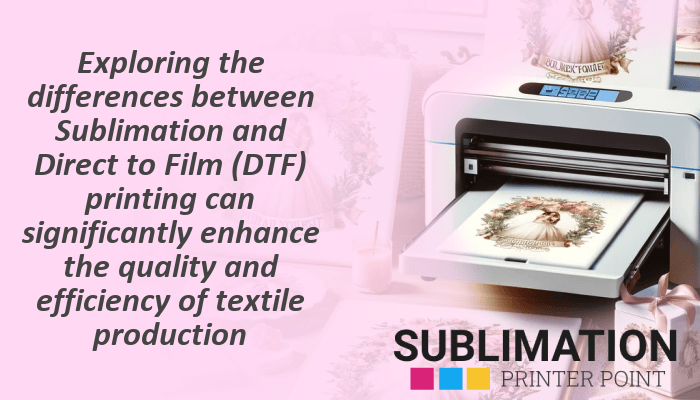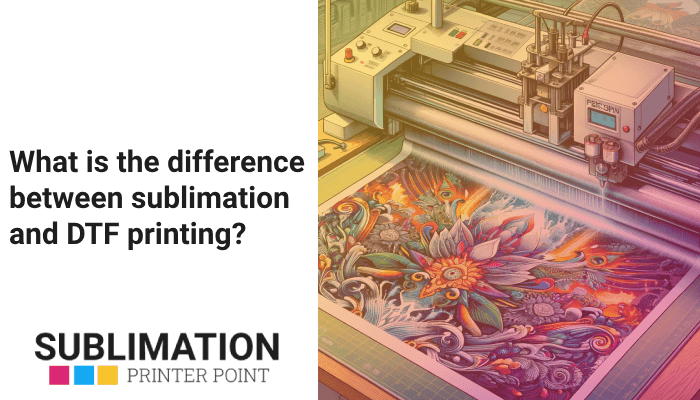Learn about direct-to-film (DTF) and sublimation printing in textile printing. Learn about their unique processes, benefits, and applications in the industry.
There are two different techniques utilized in textile printing: sublimation and DTF printing. Sublimation is a heat transfer technique that produces a gaseous ink that penetrates fabric to create a long-lasting, vibrant picture. In contrast, DTF printing entails printing an image onto a polyester film and heat-pressing it into the substrate. Due to their distinct benefits, both methods are widely used in clothing ornamentation. While DTF can be used on a number of materials and produces a print that sits on top of the cloth, sublimation is best for polyester-based materials and produces a print that is permanently dyed into the fabric.
- Sublimation printing uses heat to transfer dye onto materials like polyester, plastic, or coated aluminum.
- DTF printing prints an image onto a special film before transferring it to the fabric.
- Sublimation requires polyester-based materials and results in a print that is permanently dyed into the fabric.
- DTF can be used on a variety of materials, including cotton, and results in a print that sits on top of the fabric.
- Sublimation is limited to lighter colored fabrics, while DTF can print on both light and dark colors.
| Printing Technique | Process | Materials | Print Quality | Speed | Cost |
|---|---|---|---|---|---|
| Sublimation Printing | Uses heat to transfer dye onto materials. The ink, when heated, turns into a gas, permeating the fabric and solidifying into its fibers. | Polyester, plastic, or coated aluminum. | High-quality, durable print. Images are colorfast and don’t peel or fade. | Generally faster due to straightforward process. | Lower startup costs, ongoing costs for sublimation ink and paper. |
| DTF Printing | Prints an image onto a special type of film before transferring it to the fabric. The process begins with the application of a layer of adhesive onto the film, followed by the printing of the image using specialized DTF inks. | Wide range of fabrics, including cotton. | Vibrant, high-quality print that can adhere to a wide range of fabrics. | Slower, allows for more detailed designs. | Higher startup costs due to specialized printer and materials, cost per print can be lower for larger designs. |
The procedures, appropriate materials, print quality, speed, and cost of DTF printing and sublimation printing are compared in this table.
What are the basics of sublimation and DTF printing?
In the textile business, sublimation and Direct to Film (DTF) printing are two well-known methods, each with special advantages and procedures. Bypassing the liquid phase entirely, sublimation printing, a type of thermal transfer printing, converts ink from a solid to a gaseous state. This procedure makes it possible for the ink to seep into the fabric, producing a sharp, long-lasting image. On the other side, layer-by-layer application of ink and adhesive onto a polyester film is used in DTF printing, sometimes referred to as direct to fabric printing. The image is then transferred to the material by heat-pressing this film. Due of their unique benefits, both methods are widely used in clothing embellishment.
What is sublimation printing in the textile industry?
Sublimation printing is a method used in the textile industry to transfer dye onto materials such coated metal, polyester, and plastic using heat. Sublimation ink, heat, and pressure are used in this method to provide a high-quality, long-lasting print. Heat causes the ink to become a gas, which seeps into the cloth and solidifies into its fibers. The fabric’s pictures are colorfast and resistant to peeling and fading, giving your material a durable design.
How does DTF printing work in garment decoration?
A relatively recent technique in clothing embellishment called DTF printing prints an image first on a particular kind of film and then transfers it to the fabric. The procedure starts with putting an adhesive layer on the film and ends with printing the picture with special DTF inks. After applying a coating of adhesive powder, the printed film is heat-pressed into the clothing. The end product is a brilliant, superior print that clings to a variety of materials, including cotton.
Contrary to sublimation, did you know that DTF printing offers a greater selection of colors? This is so that there are more design alternatives available as DTF can print on fabrics that are both light and dark in hue.
What are the key differences between sublimation and DTF printing?
Although DTF and sublimation are both heat transfer printing techniques, their procedures and end products are very different. Materials based on polyester are needed for sublimation, which produces a print that is permanently colored into the fabric. In contrast, DTF produces a pattern that rests on top of the fabric and may be used on a range of materials, including cotton. Furthermore, DTF can print on both light and dark colors, whereas sublimation can only be used on materials with lighter hues. Because of these variations, any approach can be used for a variety of purposes and tastes.
How does the print technology differ between sublimation and DTF?
What role does heat transfer printing play in sublimation?
An essential component of sublimation printing is heat transfer. Sublimation is the process by which the heat converts the sublimation inks from a solid to a gas without going through a liquid phase. After entering the cloth, the gas transforms back into a solid and becomes integrated into the substance. Because of its ability to produce prints that are not only vivid but also resistant to fading or peeling, sublimation is the method of choice for long-lasting prints.
How does direct to garment printing apply in DTF?
Using specialized or modified inkjet technology, direct to garment (DTG) printing is a method that prints directly onto textiles and clothing. This technology is used in DTF printing, a type of DTG, to print an image onto a film that is subsequently transferred to the fabric. High-quality, detailed prints may be produced using this method on a wide range of materials, including cotton and other materials that are typically challenging to print on.
How does inkjet printing differ in sublimation and DTF?
In DTF and sublimation, inkjet printing technology is applied differently. Using sublimation, an image is printed using an inkjet printer onto sublimation paper, which is subsequently heat-pressed onto fabric. The ink sublimates and seeps into the fabric due to the heat. In DTF, the image is printed directly onto a film using an inkjet printer. The film is then covered in adhesive and heated to press it onto the fabric. The outcome is a brilliant, superior print that can be used on a range of surfaces.
Tip: Take into account the particular requirements of your project when deciding between DTF and sublimation. For large-scale, rapid production on polyester-based materials, sublimation works well; however, DTF works well for intricate designs on a range of materials, including cotton.
What are the considerations for print quality and durability in sublimation and DTF?
How does color management in printing affect sublimation and DTF?
To guarantee that the final print adheres to the original design, color management is essential for both DTF and sublimation printing. To obtain the desired outcome in sublimation, the color management procedure entails modifying the printer, ink, heat press, and sublimation paper. To guarantee a brilliant, high-quality print, color management in DTF entails calibrating the printer and modifying the ink and adhesive application. Effective color management can greatly improve the print quality using both methods.
What is the impact of dye sublimation ink on print durability?
Print longevity is significantly influenced by dye sublimation ink. The ink penetrates the cloth and becomes a part of it when it is sublimated. This produces a print that, even after several washings, won’t peel, crack, or fade. For this reason, using premium sublimation ink is essential to producing prints that are strong and endure a long time.
How does the use of printable vinyl influence the print quality in DTF?
The print quality of DTF printing can be greatly impacted by the use of printable vinyl. Vibrant printing and accurate application are made possible by the vinyl film’s role as a carrier for the ink and adhesive. The vinyl covering also gives the ink a flat surface to work on, improving the clarity and detail of the print. Thus, in DTF printing, the quality of the printable vinyl that is utilized can have a direct effect on the quality of the finished print.
What are the practical applications of sublimation and DTF in t-shirt printing?
How does the printing speed compare between sublimation and DTF in t-shirt printing?
Sublimation and DTF printing have different printing speeds when it comes to t-shirt printing. Because sublimation printing only requires heat pressing the design into the fabric, it is typically faster. Even said, DTF printing is slower but can print on a larger variety of textiles and accommodates more intricate designs. As a result, the particular needs of the project frequently determine which option is best.
What are the advantages of using a sublimation printer for t-shirt printing?
There are various benefits to printing t-shirts with a sublimation printer. To begin with, sublimation printers can create vivid, superior prints that won’t fade or peel. Second, the prints are permanently coloured into the fabric, giving it a smooth, silky finish without changing the texture of the fabric. Finally, because sublimation printing is a fast process, it is perfect for mass production.
Why might a DTF printer be preferred for t-shirt printing?
For printing t-shirts, a DTF printer could be the better option for a number of reasons. Unlike sublimation, DTF printing produces detailed, high-quality prints on a variety of materials, including cotton. Furthermore, DTF designs have a tactile sensation that some customers enjoy because they sit on top of the fabric. Finally, DTF printing offers more design options because it can be applied to materials with light and dark colors.

How to choose between sublimation and DTF for your printing needs?
What factors should be considered when choosing a heat press machine for sublimation or DTF?
Many considerations need to be taken into account when selecting a heat press machine for DTF or sublimation. These consist of the machine’s dimensions, temperature range, capacity for pressure adjustment, and heat platen type. The machine’s suitability for the particular printing method (sublimation or DTF) and cloth type should also be taken into account. A device that satisfies these specifications will provide long-lasting, excellent prints.
How do the costs of sublimation and DTF printing techniques compare?
Sublimation and DTF printing methods’ prices might differ depending on a number of variables. Due to the fact that sublimation printing requires less specialized equipment, it typically has lower initial costs. But over time, the recurring expenses—like sublimation ink and paper—can mount up. However, because DTF printing requires a specialized printer and supplies, it has greater initial costs. However, for larger, more intricate designs, the cost per print may be less. As a result, the decision between the two frequently comes down to the project’s budget and particular requirements.
What are the environmental considerations of sublimation and DTF printing?
Environmental factors are taken into account for both DTF printing and sublimation. Heat is used in sublimation printing to transfer the dye into the cloth, a process that can be energy-intensive. But the inks that are utilized are often water-based and devoid of dangerous substances. Conversely, DTF printing may result in waste since it requires more materials, including glue and film. Still, a lot of DTF inks are safe to use and environmentally friendly. Consequently, each approach has advantages and disadvantages in terms of the environment, and the decision frequently comes down to the project’s particular environmental objectives.

